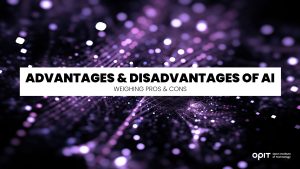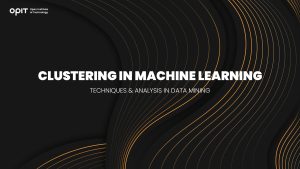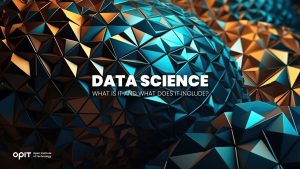
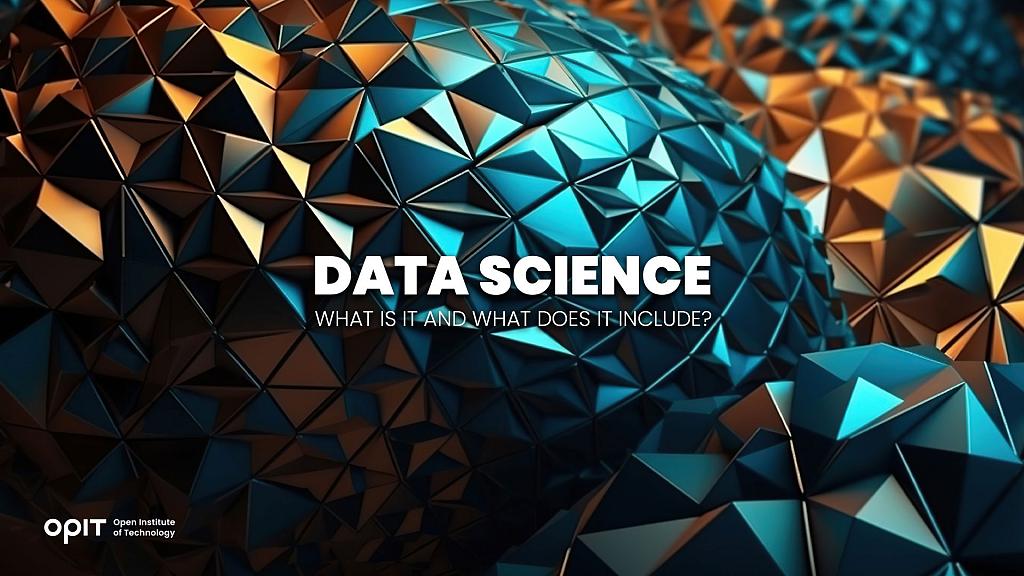
More and more companies are employing data scientists. In fact, the number has nearly doubled in recent years, indicating the importance of this profession for the modern workplace.
Additionally, data science has become a highly lucrative career. Professionals easily make over $120,000 annually, which is why it’s one of the most popular occupations.
This article will cover all you need to know about data science. We’ll define the term, its main applications, and essential elements.
What Is Data Science?
Data science analyzes raw information to provide actionable insights. Data scientists who retrieve this data utilize cutting-edge equipment and algorithms. After the collection, they analyze and break down the findings to make them readable and understandable. This way, managers, owners, and stakeholders can make informed strategic decisions.
Data Science Meaning
Although most data science definitions are relatively straightforward, there’s a lot of confusion surrounding this topic. Some people believe the field is about developing and maintaining data storage structures, but that’s not the case. It’s about analyzing data storage solutions to solve business problems and anticipate trends.
Hence, it’s important to distinguish between data science projects and those related to other fields. You can do so by testing your projects for certain aspects.
For instance, one of the most significant differences between data engineering and data science is that data science requires programming. Data scientists typically rely on code. As such, they clean and reformat information to increase its visibility across all systems.
Furthermore, data science generally requires the use of math. Complex math operations enable professionals to process raw data and turn it into usable insights. For this reason, companies require their data scientists to have high mathematical expertise.
Finally, data science projects require interpretation. The most significant difference between data scientists and some other professionals is that they use their knowledge to visualize and interpret their findings. The most common interpretation techniques include charts and graphs.
Data Science Applications
Many questions arise when researching data science. In particular, what are the applications of data science? It can be implemented for a variety of purposes:
- Enhancing the relevance of search results – Search engines used to take forever to provide results. The wait time is minimal nowadays. One of the biggest factors responsible for this improvement is data science.
- Adding unique flair to your video games – All gaming areas can gain a lot from data science. High-end games based on data science can analyze your movements to anticipate and react to your decisions, making the experience more interactive.
- Risk reduction – Several financial giants, such as Deloitte, hire data scientists to extract key information that lets them reduce business risks.
- Driverless vehicles – Technology that powers self-driving vehicles identifies traffic jams, speed limits, and other information to make driving safer for all participants. Data science-based cars can also help you reach your destination sooner.
- Ad targeting – Billboards and other forms of traditional marketing can be effective. But considering the number of online consumers is over 2.6 billion, organizations need to shift their promotion activities online. Data science is the answer. It lets organizations improve ad targeting by offering insights into consumer behaviors.
- AR optimization – AR brands can take a number of approaches to refining their headsets. Data science is one of them. The algorithms involved in data science can improve AR machines, translating to a better user experience.
- Premium recognition features – Siri might be the most famous tool developed through data science methods.
Learn Data Science
If you want to learn data science, understanding each stage of the process is an excellent starting point.
Data Collection
Data scientists typically start their day with data collection – gathering relevant information that helps them anticipate trends and solve problems. There are several methods associated with collecting data.
Data Mining
Data mining is great for anticipating outcomes. The procedure correlates different bits of information and enables you to detect discrepancies.
Web Scraping
Web scraping is the process of collecting data from web pages. There are different web scraping techniques, but most professionals utilize computer bots. This technique is faster and less prone to error than manual data discovery.
Remember that while screen scraping and web scraping are often used interchangeably, they’re not the same. The former merely copies screen pixels after recognizing them from various user interface components. The latter is a more extensive procedure that recovers the HTML code and any information stored within it.
Data Acquisition
Data acquisition is a form of data collection that garners information before storing it on your cloud-based servers or other solutions. Companies can collect information with specialized sensors and other devices. This equipment makes up their data acquisition systems.
Data Cleaning
You only need usable and original information in your system. Duplicate and redundant data can be a major obstacle, which is why you should use data cleaning. It removes contradictory information and helps you separate the wheat from the chaff.
Data Preprocessing
Data preprocessing prepares your data sets for other processes. Once it’s done, you can move on to information transformation, normalization, and analysis.
Data Transformation
Data transformation turns one version of information into another. It transforms raw data into usable information.
Data Normalization
You can’t start your data analysis without normalizing the information. Data normalization helps ensure that your information has uniform organization and appearance. It makes data sets more cohesive by removing illogical or unnecessary details.
Data Analysis
The next step in the data science lifecycle is data analysis. Effective data analysis provides more accurate data, improves customer insights and targeting, reduces operational costs, and more. Following are the main types of data analysis:
Exploratory Data Analysis
Exploratory data analysis is typically the first analysis performed in the data science lifecycle. The aim is to discover and summarize key features of the information you want to discuss.
Predictive Analysis
Predictive analysis comes in handy when you wish to forecast a trend. Your system uses historical information as a basis.
Statistical Analysis
Statistical analysis evaluates information to discover useful trends. It uses numbers to plan studies, create models, and interpret research.
Machine Learning
Machine learning plays a pivotal role in data analysis. It processes enormous chunks of data quickly with minimal human involvement. The technology can even mimic a human brain, making it incredibly accurate.
Data Visualization
Preparing and analyzing information is important, but a lot more goes into data science. More specifically, you need to visualize information using different methods. Data visualization is essential when presenting your findings to a general audience because it makes the information easily digestible.
Data Visualization Tools
Many tools can help you expedite your data visualization and create insightful dashboards.
Here are some of the best data visualization tools:
- Zoho Analytics
- Datawrapper
- Tableau
- Google Charts
- Microsoft Excel
Data Visualization Techniques
The above tools contain a plethora of data visualization techniques:
- Line chart
- Histogram
- Pie chart
- Area plot
- Scatter plot
- Hexbin plots
- Word clouds
- Network diagrams
- Highlight tables
- Bullet graphs
Data Storytelling
You can’t have effective data presentation without next-level storytelling. It contextualizes your narrative and gives your audience a better understanding of the process. Data dashboards and other tools can be an excellent way to enhance your storytelling.
Data Interpretation
The success of your data science work depends on your ability to derive conclusions. That’s where data interpretation comes in. It features a variety of methods that let you review and categorize your information to solve critical problems.
Data Interpretation Tools
Rather than interpret data on your own, you can incorporate a host of data interpretation tools into your toolbox:
- Layer – You can easily step up your data interpretation game with Layer. You can send well-designed spreadsheets to all stakeholders for improved visibility. Plus, you can integrate the app with other platforms you use to elevate productivity.
- Power Bi – A vast majority of data scientists utilize Power BI. Its intuitive interface enables you to develop and set up customized interpretation tools, offering a tailored approach to data science.
- Tableau – If you’re looking for another straightforward yet powerful platform, Tableau is a fantastic choice. It features robust dashboards with useful insights and synchronizes well with other applications.
- R – Advanced users can develop exceptional data interpretation graphs with R. This programming language offers state-of-the-art interpretation tools to accelerate your projects and optimize your data architecture.
Data Interpretation Techniques
The two main data interpretation techniques are the qualitative method and the quantitative method.
The qualitative method helps you interpret qualitative information. You present your findings using text instead of figures.
By contrast, the quantitative method is a numerical data interpretation technique. It requires you to elaborate on your data with numbers.
Data Insights
The final phase of the data science process involves data insights. These give your organization a complete picture of the information you obtained and interpreted, allowing stakeholders to take action on company problems. That’s especially true with actionable insights, as they recommend solutions for increasing productivity and profits.
Climb the Data Science Career Ladder, Starting From the Basics
The first step to becoming a data scientist is understanding the essence of data science and its applications. We’ve given you the basics involved in this field – the rest is up to you. Master every stage of the data science lifecycle, and you’ll be ready for a rewarding career path.
Related posts

Source:
- Times of Malta, published on September 18th, 2025
4 min read
The gathering brought together academics and technology leaders from prominent European Institutions, such as Instituto de Empresa (IE University), OPIT itself and the Royal College of Arts, to explore how artificial intelligence is reshaping the university experience.
The OPIT AI Copilot has been trained on the institute’s complete academic archive, a collection created over the past three years that includes 131 courses, more than 3,500 hours of recorded lectures, 7,500 study resources, 320 certified assessments, and thousands of exercises and original learning documents.
Unlike generic AI tools, the Copilot is deeply integrated with OPIT’s learning management system, allowing it to track each student’s progress and provide tailored support.
This integration means the assistant can reference relevant sources within the learning environment, adapt to the student’s stage of study, and ensure that unreleased course content remains inaccessible.
A mobile app is also scheduled for release this autumn, that will allow students to download exercise and access other tools.
During examinations, the Copilot automatically switches to what the institute calls an “anti-cheating mode”, restricting itself to general research support rather than providing direct answers.
For OPIT’s international community of 500 students from nearly 100 countries, many of whom balance studies with full-time work, the ability to access personalised assistance at any time of day is a key advantage.
“Eighty-five per cent of students are already using large language models in some way to study,” said OPIT founder and director Riccardo Ocleppo. “We wanted to go further by creating a solution tailored to our own community, reflecting the real experiences of remote learners and working professionals.”
Tool aims to cut correction time by 30%
The Copilot will also reduce administrative burdens for faculty. It can help grade assignments, generate new educational materials, and create rubrics that allow teachers to cut correction time by as much as 30 per cent.
According to OPIT, this will free up staff to dedicate more time to teaching and direct student engagement.
At the Milan event, Rector Francesco Profumo underlined the broader implications of AI in higher education. “We are in the midst of a deep transformation, where AI is no longer just a tool: it is an environment that radically changes how we learn, teach, and create,” he said.
“But it is not a shortcut. It is a cultural, ethical, and pedagogical challenge, and to meet it we must have the courage to rethink traditional models and build bridges between human and artificial intelligence.”
OPIT was joined on stage by representatives from other leading institutions, including Danielle Barrios O’Neill of the Royal College of Art, who spoke about the role of AI in art and creativity, and Francisco Machin of IE University, who discussed applications in business and management education.
OPIT student Asya Mantovani, also employed at a leading technology and consulting firm in Italy, gave a first-hand account of balancing professional life with online study.
The assistant has been in development for the past eight months, involving a team of OPIT professors, researchers, and engineers.
Ocleppo stressed that OPIT intends to make its AI innovations available beyond its own institution. “We want to put technology at the service of higher education,” he said.
“Our goal is to develop solutions not only for our own students, but also to share with global institutions eager to innovate the learning experience in a future that is approaching very quickly.”
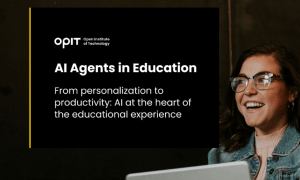
From personalization to productivity: AI at the heart of the educational experience.
Click this link to read and download the e-book.
At its core, teaching is a simple endeavour. The experienced and learned pass on their knowledge and wisdom to new generations. Nothing has changed in that regard. What has changed is how new technologies emerge to facilitate that passing on of knowledge. The printing press, computers, the internet – all have transformed how educators teach and how students learn.
Artificial intelligence (AI) is the next game-changer in the educational space.
Specifically, AI agents have emerged as tools that utilize all of AI’s core strengths, such as data gathering and analysis, pattern identification, and information condensing. Those strengths have been refined, first into simple chatbots capable of providing answers, and now into agents capable of adapting how they learn and adjusting to the environment in which they’re placed. This adaptability, in particular, makes AI agents vital in the educational realm.
The reasons why are simple. AI agents can collect, analyse, and condense massive amounts of educational material across multiple subject areas. More importantly, they can deliver that information to students while observing how the students engage with the material presented. Those observations open the door for tweaks. An AI agent learns alongside their student. Only, the agent’s learning focuses on how it can adapt its delivery to account for a student’s strengths, weaknesses, interests, and existing knowledge.
Think of an AI agent like having a tutor – one who eschews set lesson plans in favour of an adaptive approach designed and tweaked constantly for each specific student.
In this eBook, the Open Institute of Technology (OPIT) will take you on a journey through the world of AI agents as they pertain to education. You will learn what these agents are, how they work, and what they’re capable of achieving in the educational sector. We also explore best practices and key approaches, focusing on how educators can use AI agents to the benefit of their students. Finally, we will discuss other AI tools that both complement and enhance an AI agent’s capabilities, ensuring you deliver the best possible educational experience to your students.
Have questions?
Visit our FAQ page or get in touch with us!
Write us at +39 335 576 0263
Get in touch at hello@opit.com
Talk to one of our Study Advisors
We are international
We can speak in:

